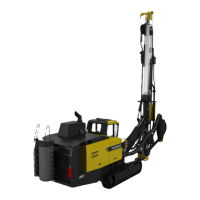SmartROC D65 Tier 4 Final 2 General
24
Occurrence of wire breaks due to operating time.
Wire breaks occur first after a certain operating time depending on operating conditions
and subsequently occur more frequently.
If this is the case, the number of wire breaks in relation to the operating time should be de-
termined and documented.
This can then be used to estimate the future increase in wire breaks and the foreseeable
time point for scrapping.
Reduced elasticity
Under certain conditions, the cable loses its elasticity.
Reduced elasticity is difficult to detect. If in doubt, consult a specialist.
If the cable has lost elasticity, the following characteristics usually appear:
n Decrease in cable diameter
n Extension of the cable
n No gap between individual wires and between the strands. This is caused by its com-
ponents being pressed together.
n Fine, brown dust inside the strands.
n Even if there are no visible wire breaks, the cable is noticeably stiffer.
n The cable's diameter decreases more quickly than during normal wear of the individual
cable strands.
Reduced elasticity can lead to sudden cable breaks during heavy loads. The cable should
be scrapped.
Decrease in cable diameter
Decrease in cable diameter through material fatigue in the cable can have the following
causes:
n Inner surface wear and surface wear nicks
n Inner surface wear through friction between the strands and wires in the cable
n Fatigue of plastic core
n Break in steel core
n Break in inner layer in multi-strand cable
If the cable's diameter decreases more than 10% in relation to the nominal diameter of the
cable, it must be scrapped.
It should be scrapped even if no wire breaks have been detected.
Certain number and type of wire breaks
The cable drums are designed in such a way that the cables do not have an unlimited ser-
vice life. Wire breaks can therefore occur during operation.
On 6 and 8-strand cables, wire breaks are primarily superficial.
The cables should be scrapped if the number of wire breaks specified in the table have
been detected
Number of load-
bearing wires in
the outer strand
1
n
Number of visible wire breaks
2
that require scrapping
Machine groups M1 and M2
Cross lay Equal lay

